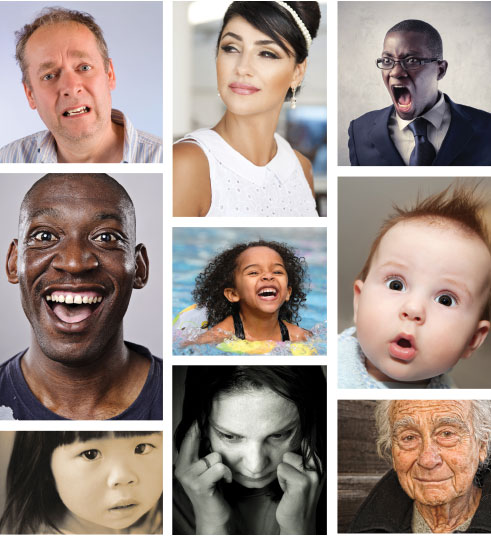Web Page: Active Listening
Video: JFK's "We Choose to Go to the Moon" Speech
Video: Giant Squid News Interview
Video: Hamlet's Soliloquy (David Tennant)
Web Page: Facial Expressions
Video: Gestures and Body Language
Hearing involves the ears. Listening involves the mind. Earlier, we looked at the different levels of thinking, which also apply to listening. Below, you will see that as thinking becomes deeper, listening becomes more active.


Levels of Thinking | Levels of Listening |
Remembering |
|
Understanding |
|
Applying |
|
Analyzing |
|
Evaluating |
|
Creating |
|
In the chart above, note that each level of listening ends with a response option. For example, at the shallowest level, you might show that you are listening simply by repeating the message back to the person. At a deeper level, you would reflect on the meaning. You might also connect the message to other ideas, question its purpose, or suggest improvements. The depth of conversation relates directly to the depth of thinking and level of listening that you apply.
Your Turn With a partner, begin a conversation by completing the following sentence: “The most interesting thing I learned today was . . .” The partner then responds at the “remembering” level of listening, following one of the bulleted points there. You reply by explaining more about the interesting thing that you learned, and the partner responds at the “understanding” level. Keep the conversation going to the deepest levels of thinking and the most active levels of listening. Discuss the difference in responses at various levels. Then switch roles and repeat.
Listening begins as we receive the words that come to us. We hear them with our ears, and our brains turn the sounds into sentences and extract their meaning. This page focuses on the parts of a message that you should think about when listening.
Your Turn Social Studies: Find a video of a famous speech and listen to it. Then write down the subject, main point, support, purpose, implications, and outcome of the speech.
Science: Search online for a scientific news conference in which a discovery is presented. Listen. Write down the subject, main point, support, purpose, implications, and outcome.
Math: Think about your most recent math lecture. Write down the subject, main point, support, purpose, implications, and outcome of the lecture.
English: Search online to find famous soliloquies (solo speeches) from plays. Choose one. Write down the subject, main point, support, purpose, implications, and outcome of the soliloquy.
Home: Listen to a conversation at home, whether at the dinner table, in front of the TV, or on the front stoop. Think about the subject, main point, support, purpose, implication, and outcome.

Voice reveals a speaker’s connection to each part of the communication situation. As you listen to a speaker, think about what his or her voice is telling you.
Sender:Voice reveals the speaker’s identity (who he or she is), personality (bubbly, quiet, gruff), and position (teacher, entertainer, cop). It reveals the person’s gender and age and how the person is feeling. Consider the examples to the right. | “Um, Mrs. Willis? I, uh, well . . . my homework’s at home.” “It is, is it? That would be the second time this week, Mr. Jones.” |
Message:Voice reveals the speaker’s opinion of the subject (lighthearted, grave, flippant, confused, worried). Voice also reveals what the person’s purpose is for sharing this message (consoling, joking, cajoling, informing). | “Huh, yeah, and second time my dog ate it. Need a new dog.” “You won’t be laughing when you see your grade for this class.” |
Medium:Voice reveals how capable the speaker is with the communication medium. In spoken language, voice shows if the person feels confident or not and what level of proficiency the person has. | “I, uh. Yeah. Both of ’em. Sure. I gotta do both assignments.” “That’s what you’ve got to do.” |
Receiver:Voice reveals the speaker’s relationship to the audience (formal, congenial, combative, businesslike). Voice also shows the relative position of the speaker (superior, equal, subordinate). | “I’ll make it up. I swear. I’ll turn it in tomorrow and do extra credit.” “You’ll turn in this assignment and the last one as well.” |
Context:Voice reveals the speaker’s perception of the situation that surrounds the message. It tells how the person thinks the message fits in with other messages and circumstances. | “I promise. I know I promised before, but this time I mean it.” “Good. I’ve threatened before, and this time I mean it, too.” |
Your Turn Listen to a conversation in a movie, or read a conversation in a novel or short story. Choose one of the people in the conversation and indicate what the person’s voice tells about all aspects of the communication situation.
A recent study of South American primates discovered that the more solitary a species is, the more elaborate the facial markings are. The more social a species, the more plain the faces. That’s because plain faces more easily form expressions that communicate emotion. Human faces are plainer and more expressive than monkey faces. As you listen, make sure to read the facial expressions of the speaker.

Your Turn Identify the emotion behind the facial expression above. Compare your answers with a partner’s. Discuss any differences, and indicate the facial evidence for the emotion you identified.
As with facial expressions, body language also communicates. In fact, our faces and bodies tend to be honest about our feelings even when our words are not. That’s because, as infants, we expressed ourselves physically long before we did verbally.

Your Turn For each picture above, indicate what the body language is expressing. Compare your answers with a partner’s and discuss any differences. Indicate what posture cues support your response.
Web Page: Active Listening
Video: JFK's "We Choose to Go to the Moon" Speech
Video: Giant Squid News Interview
Video: Hamlet's Soliloquy (David Tennant)
Web Page: Facial Expressions
Video: Gestures and Body Language
© 2014 Thoughtful Learning
